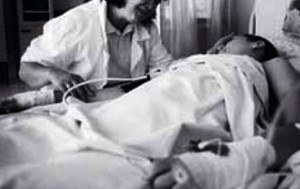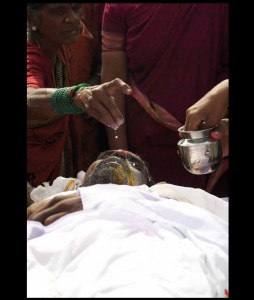 We well know that the culture in which we are immersed engages in a removal of death from the social scene: death today is de-socialised, reduced to an individual phenomenon, and is hidden, concealed, ripped from places where people live (homes) and relegated, most of the time, to those ascetic contexts – hospitals. Today one dies in a way that is certainly more hygienic than was once the case but one also dies also in greater loneliness. (12)
We well know that the culture in which we are immersed engages in a removal of death from the social scene: death today is de-socialised, reduced to an individual phenomenon, and is hidden, concealed, ripped from places where people live (homes) and relegated, most of the time, to those ascetic contexts – hospitals. Today one dies in a way that is certainly more hygienic than was once the case but one also dies also in greater loneliness. (12)
The removal of death is a phenomenon that can be seen in fear of the word ‘death’ itself which is often replaced by those pitiful and illusory examples of camouflage – euphemisms. Today people do not die, they pass away, they leave their loved ones, they go on to a better life…Repulsion in the face of a coffin, children distanced from seeing a dead person, the reduction of a mortal illness to a technical problem that is entrusted to specialised people, and the bureaucratic character of funeral procedures, are all further manifestations of this phenomenon which relegates death to non-life, they distance it from society and make it obscene (in the etymological sense of excluding it from the ‘scene’ of living).
And yet death is an integral part and a culminating moment of existence. To restore humanity and dignity to dying so that death can be experienced as a human act that not only ends life but which also completes it is an urgent duty for a culture that wants to be authentically respectful of the human. This removal of death also explains why the value of accompanying a dying person has disappeared at a social and familial level. (13) In truth, the time that precedes death is extremely valuable – it is an opportunity for a sick person to assess his or her own life and to re-affirm the options that have guided his or her own existence. It is a moment when he or she expresses the need to be reconciled with his or her past (with himself or herself and with the people with whom he or she is in tension or conflict) in order to be able to draw his or her own life to a close in a serene way. It is a time to deal with economic matters and situations or work questions in order not to leave anything not dealt with. It is a time that is needed to see his or her loved ones and say ‘adieu’ to them. (14)…
To be at the side of a terminally-ill person means to be at the side of a person who is going through a crucial moment of existence: we should not even speak about ‘the dying’ but, rather, of people who are living through the last days or weeks of their lives. And those who live through this accompanying can experience how those who are about to die can teach a great deal to those who go on living: interaction with the death of another person immediately directs us to what is essential and central in existence. (15) A terminally-ill person certainly experiences physical pain, but he or she also experiences anxiety, self-devaluation, spiritual dismay, and feelings of guilt. It is essential for this person to find a human space that will enable him or her to express and give voice to what he or she feels; if he or she is looked after in his or her own home, this is certainly easier. In valuing the simple gestures of daily life and offering the sick person the possibility of a real conversation, in which he or she can express himself or herself, the sick person can feel at his or her side that loving presence that is no less therapeutic than pharmacological treatment and which he or she needs in an absolute sense.
The family relative or accompanier who is at the side of the sick person should try to implement a form of communication of such a kind as to be able to reach the sick person: words, certainly, but when these are not possible, a look, a smile, tears, touching with delicacy and tenderness, holding the hand of the sick person: all these become possible pathways. Indeed, there is a voice that touches, a tone of voice that caresses, and there is a hand that speaks, a gesture that whispers. During moments of despair and anxiety it can happen that the dying person, like a little child, calls for his mother. In this circumstance, the gesture of ‘cradling’ the sick person, of taking him or her to one’s breast and holding him or her with tenderness could give him or her the security and the sense of protection that will reassure him or her. The accompanier does not have a great deal to do: he or she must only communicate a loving presence. It is this nearness that removes the sick person from the most painful of  sensations: that of being abandoned, excluded from the world of the living. For that matter, suitably interpreted by listening to the suffering from which it springs, the request to ‘finish it’ which the sick person at times expresses in the majority of cases is not in the least a request for ‘euthanasia’ but, rather, a supplication by which the patient asks for a relief of pain and not to be left in loneliness. He or she asks whether the living are still interested in him or her, in whether he or she is still worthy of love, and if he or she should be seen as still being a human being. (16)Here we encounter the task of the accompanier which is to uphold the sick person in his nor her dignity and value, even if illness paralyses or disfigures him or her to the point of making that person unrecognisable to himself or herself.
sensations: that of being abandoned, excluded from the world of the living. For that matter, suitably interpreted by listening to the suffering from which it springs, the request to ‘finish it’ which the sick person at times expresses in the majority of cases is not in the least a request for ‘euthanasia’ but, rather, a supplication by which the patient asks for a relief of pain and not to be left in loneliness. He or she asks whether the living are still interested in him or her, in whether he or she is still worthy of love, and if he or she should be seen as still being a human being. (16)Here we encounter the task of the accompanier which is to uphold the sick person in his nor her dignity and value, even if illness paralyses or disfigures him or her to the point of making that person unrecognisable to himself or herself.
This is the message that the accompanier provides to the sick person: you are and you remain a human being, in the fullness of your dignity. The very irregular breathing of the dying person declares that in his or her anxiety, there is a search for a personal presence that is with him or her and provides calm. In this calm, the sick person will also feel authorised, when he or she feels that his or her moment has come, to leave behind ties with life and pass over the threshold of death. And even when the sick person appears to be far away, seems not to understand, not to communicate and not to respond, there must be perseverance in being near that sick person: if that person is left or does not receive closeness, or is not spoken to or communicated with in a non-verbal way, he or she is already seen as already dead and is abandoned to his or her death.
Those who are at the side of a terminally-ill person are faced with their own suffering and vulnerability, and with the emotions that the death of another provokes in them. They must recognise but also manage and keep at a distance all of this so that their own suffering does not overlay the suffering of the sick person, thereby impeding the accompaniers from listening to the pain and the needs of the sick person. It is certainly tiring and burdensome to accompany a dying person but this is an act of great humanity which can enrich in a profound way those who engage in it. In a cultural context that exalts pleasure, efficacy, superficial beauty and success, it is difficult to grasp the meaning and the value of the last moments of a dying man. Indeed, the spectacle of human frailty, of a body without strength, shaken by laborious breathing, can be experienced as something that is terrifying! But these are the last moments, the last gestures, the last looks, perhaps the last smiles of a person with whom we have shared a pathway of life. This is of extraordinary importance. And a Christian can face up to this task by reference to the authority of a paraphrase, that is certainly legitimate, of Matthew 25:35-36: ‘I was dying and you were at my side’ .














Camillians on Facebook
Camillians on Twitter
Camillians on Instagram